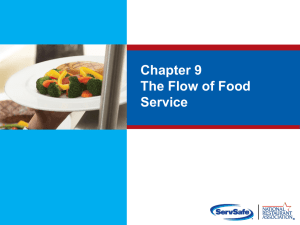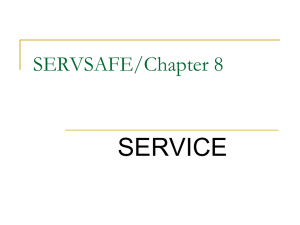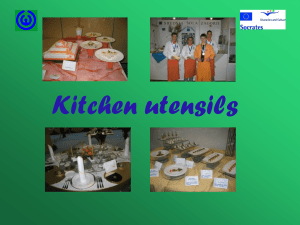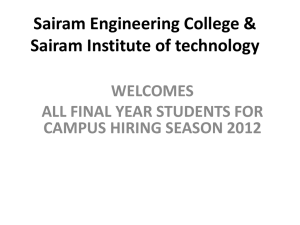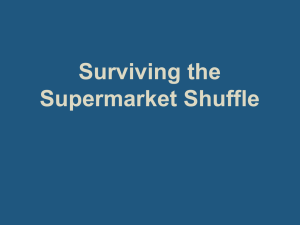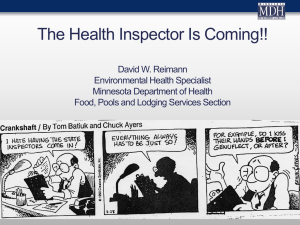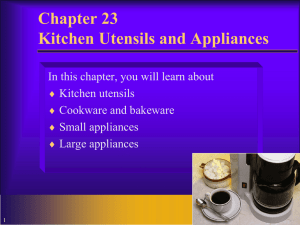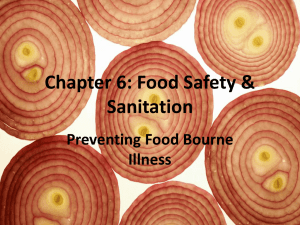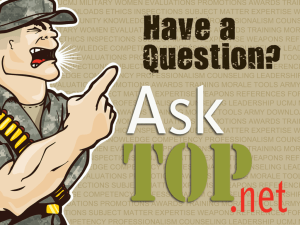PowerPoint
advertisement
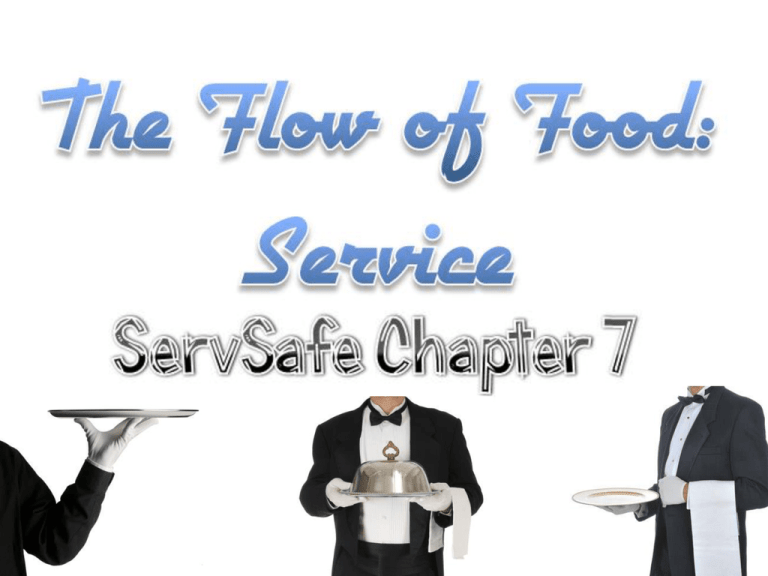
• Food that is being held for service is at risk for time-temperature abuse and crosscontamination. • Operations must create policies for how they will hold food. • Policies should consider the following: • Cover food and install sneeze guards to protect food from contaminants. • Covers also help maintain a food’s internal temperature • Hold TCS food at the correct internal temperature. – Hold hot food at 135°F or higher. – Hold cold food at 41°F or lower. • Use a thermometer to check a food’s internal temperature. • NEVER use the temperature gauge on a holding unit to do it. The gauge does not check the internal temperature of the food. • Check food temperature at least every four hours. – Throw out food that is not 41°F or lower, or 135°F or higher. – You can also check the temperature every two hours. This will leave time for corrective action. • NEVER use hot-holding equipment to reheat food unless it is built to do so. Most hotholding equipment does not pass food through the temperature danger zone quickly enough. • Reheat food correctly. Then move it to the holding unit. • An operation might want to hold food without temperature control like these situations: – Displaying food for a short time, such as at an offsite catered event – When electricity is not available to power holding equipment • Note that the conditions for holding cold food are different from those for holding hot food. • You can hold food without temperature control for up to six hours if you meet these conditions: – Hold the food at 41°F or lower before removing it from refrigeration. – Label the food with the time you removed it from refrigeration and the time you must throw it out. This discard time on the label must be six hours from the time you removed the food from refrigeration. – Make sure the food temperature does not exceed 70°F while it is being served. Throw out any food that exceeds 70°F. – Sell, serve, or throw out the food within six hours. • You can hold hot food without temperature control for up to four hours if you meet these conditions: – Hold the food at 135°F or higher before removing it from temperature control – Label the food with the time you must throw it out. The discard time on the label must be four hours form the time you removed the food from temperature control – Sell, serve or throw out the food within four hours • Bare-hand contact with food – Food handlers must wear single-use gloves whenever handling ready-to-eat food. – As an alternative, food can be handled with spatulas, tongs, deli sheets, or other utensils. • Clean and sanitized utensils – Use separate utensils for each food item. – Clean and sanitize them after each serving task. – If using utensils continuously, clean and sanitize them at least once every four hours. • Serving utensils – Store serving utensils in the food with the handle extended above the rim of the container. – You can also place them on a clean and sanitized food-contact surface. – Spoons or scoops used to serve food such as ice cream or mashed potatoes can be stored under running water that is 135°F. • Hold dishes by the bottom or edge. • Hold glasses by the middle, bottom, or stem. • Do NOT touch the foodcontact areas of dishes or glassware. • Carry glasses in a rack or on a tray to avoid touching the food-contact surfaces. • Do NOT stack glasses when carrying them. • Hold flatware by the handle. • Do NOT hold flatware by foodcontact surfaces. • Store flatware so that servers grasp handles, not food-contact surfaces. • Avoid bare-hand contact with food that is ready to eat. • Use ice scoops or tongs to get ice. • NEVER scoop ice with your bare hands or a glass. A glass may chip or break. • If an operation presets tableware on dining tables, you must take steps to prevent it from becoming contaminated. This could include wrapping or covering them. • Table settings do not need to be wrapped or covered if extra, or unused settings meet these requirements: – They are removed when guests are seated. – If they remain on the table, they are cleaned and sanitized after guests have left. • Do NOT re-serve food returned by one customer to another customer. • Do NOT re-serve uneaten bread to other customers. Change linens used in bread baskets after each customer. • NEVER re-serve plate garnishes, such as fruit or pickles, to another customer. Throw out served but unused garnishes. • Condiments – You must protect condiments from contamination. Serve them in their original containers or in containers designed to prevent contamination. – Offering condiments in individual packets or portions can also help keep them safe. NEVER re-serve uncovered condiments. – Do NOT combine leftover condiments with fresh ones. – Throw away opened portions or dishes of condiments after serving them to customers. – Salsa, butter, mayo and ketchup are examples. • Prepackaged food – In general, you may re-serve only unopened, prepackaged food in good condition. – These include condiment packets and wrapped crackers. – You may re-serve bottles of ketchup, mustard, and other condiments. – The containers must remain closed between uses. • Protection – Food on display can be protected from contamination using sneeze guards. – They should be located 14 inches above the counter and should extend 7 inches beyond the food. – Food can also be protected by placing it in a display cases or by packaging it in a way that will protect it from contamination. – Whole, raw fruits and vegetables and nuts in the shell that require peeling or hulling before eating do not require the protection measures discussed above. • Labels – Label food located in self-service areas. – For example, place the name of the food, such as types of salad dressings, on ladle handles. • Temperature – Keep hot food hot, 135°F or higher. – Keep cold food cold, 41°F or lower. • Raw and Ready-to-Eat Food – Typically, raw, unpackaged meat, poultry, and seafood cannot be offered for self-service. However these items are an exception: • Ready-to-eat food at buffets or salad bars that serve food such as sushi or raw shellfish • Ready-to-cook portions that will be cooked and eaten immediately on the premises, such as at Mongolian barbeques. • Raw, frozen, shell-on shrimp or lobster. • Refills – Do NOT let customers refill dirty plates or use dirty utensils at self-service areas. – Pathogens such as Norovirus can easily be transferred by reused plates and utensils. – Assign a staff member to monitor guests. – Post signs reminding customers not to reuse plates and utensils. • Utensils – Stock food displays with the correct utensils for dispensing food. – This might include tongs, ladles, or deli sheets. • Ice – Ice used to keep food or beverages cold should NEVER be used as an ingredient. • Bulk food in self-service areas must be labeled. The label must be in plain view of the customer. • When labeling food, you can include the manufacturer or processor label provided with the food. • As an alternative, you can provide the information using a card, sign or other labeling method. • Bulk unpackaged food, such as bakery products and unpackaged food portioned for customers, does not need to be labeled if it meets these conditions: – The product makes not claim regarding health or nutrient content – There are not laws requiring labeling – The food is manufactured or prepared on the premises – The food is manufactured or prepared at another food operation or processing plant owned by the same person. The operation must be regulated. • Delays from the point of preparation to the point of service increase the risk that food will exposed to contamination or timetemperature abuse. • To transport correctly, follow these procedures: • Food containers – Pack food in insulated food containers. – Use only food-grade containers. – They should be designed so food cannot mix, leak or spill. – At the service site, use appropriate containers or equipment to hold food at the correct temperature. • Delivery vehicles – Clean the inside of delivery vehicles regularly. • Internal temperatures – Check the internal food temperatures. – If containers or delivery vehicles are not holding food at the correct temperature, reevaluate the length of the delivery route or the efficiency of the equipment being used. • Utilities – Make sure the service site has the correct utilities. • Safe water for cooking, dishwashing, and handwashing. • Garbage containers stored away from food-prep, storage, and serving areas. • Labels – Label food with a use-by date and time, and reheating and service instructions for staff at offsite locations. • Storage – Store raw meat, poultry and seafood and ready-to-eat items separately. • Handle food prepped and packaged for vending machines with the same care as any other food served to customers. • Vending operators should protect food from contamination and time-temperature abuse during transport, delivery and service. • Check product shelf life daily. Products often have a code date, such as an expiration or useby date. If the date has expired, throw out the food immediately. Throw out refrigerated food prepped on-site if not sold within seven days of preparation. • Keep TCS food at the correct temperature. It should be held at 41°F or lower or at 135°F or higher. These machines must have controls that prevent TCS food from being dispensed if the temperature stays I the danger zone for a specified amount of time. This food must be thrown out. • Dispense TCS food in its original container. • Wash and wrap fresh fruit with edible peels before putting it in a machine. • Which part of the plate should a food handler avoid touching when serving customers? A.Bottom B. Edge C. Side D.Top • An operation has a small salad bar with 8 different items on it. How many serving utensils are needed to serve the items on the salad bar? A. 2 B. 4 C. 6 D. 8 • At what maximum internal temperature should cold TCS food be held? A. 0°F B. 32°F C. 41°F D. 60°F • What item must customers take each time they return to a selfservice area for more food? A. Clean plate B. Extra napkins C. Hand sanitizer D. New serving spoon • At what minimum temperature should hot TCS food be held? A.115°F B. 125°F C. 135°F D.145°F • An operation is located in a jurisdiction that allows it to hold TCS food without temperature control. How many hours can it display hot TCS food without temperature control before the food must be sold, served, or thrown out? A. B. C. D. 2 4 6 8 • Which food items can be displayed in a self-service area without the use of packaging, sneeze guards, or a display case to protect them from contamination? A. B. C. D. Bulk deli rolls Nuts in the shell Sushi-grade fish Cooked shrimp • What is the maximum distance that sneeze guards can be located from the self-service counter to protect food from contamination? A. 8 inches B. 10 inches C. 12 inches D. 14 inches
